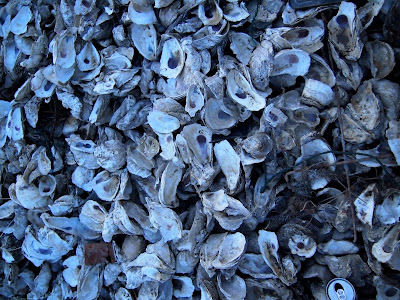Lau Fau Shan (流浮山) is a fishing village on the North coast of Hong Kong's New Territories, facing Shenzhen in mainland China. It is traditionally known for its huge harvest of oysters - apparently it used to produce one hundred tons of oysters per year. However, since the village’s younger generations moved away, the oyster harvests have reduced significantly, and now Lau Fau Shan is well known for its street of seafood restaurants. It is rammed with families and tourists during festivals and bank holidays, who come to this little village for the freshest seafood.
The first thing you would notice when arriving at the seafood street is the smell. Along with all the seafood stalls and restaurants, there are shops selling dried foods - oysters, prawns, fish stomachs, duck gizzards, etc. These can be used for making soup, or steamed with rice - even soaked and then used in a stir-fry. Almost any food you name can be found in dried form!
It could be quite confusing for the first timer, as it is pretty hard to work out exactly how much the meal will cost. Most of the restaurants in the seafood street have a very similar pricing system. The total amount you pay includes the price of the seafood, which the restaurants will pay directly to the seafood stall, plus a fee to the restaurant for cooking and service. Do let them know your budget so they can suggest the type and amount of seafood you need. We always go to the stall with the restaurant staff to make sure the seafood they pick is fresh and at reasonable price.
Siu Tao Yuen
We usually go to Siu Tao Yuen when there is a big family gathering. It is one of the bigger restaurants in Lau Feu Shan, which offers private dining rooms and free parking for diners. The food is generally high standard and relatively good value, but the cooking can vary, especially during festivals and weekends.
One of my all time favourites is Mantis prawn - the Cantonese name literally means ‘pissing prawn’, because it shoots water out of its tummy when caught. The mantis prawn is not actually a prawn, it just looks like one. The most common and delicious way of cooking them is frying with chili, salt and pepper. The flesh is sweet, and it has a texture close to lobster or langoustine. The shell is quite hard and it does take years of practice to master the de-shelling process, but once you have reached the meat, you will agree that it was all worthwhile.
We also had...
Sea whelks in spicy rice wine sauce
Steamed abalone with ginger and spring onion
Lobster in Chinese style cheese sauce (see my own version here!)
Deep fried fish belly
小桃園海鮮酒家 Siu Tao Yuen, 28 Ching Tai Street, Lau Fau Shan
Waterside Seafood Restaurant
This is my favourite restaurant in Lau Fau Shan. This family run restaurant may not be as big as Siu Tao Yuen, but it is certainly as busy, and they never disappoint! I usually go with my parents, so we do not need to compete for the big tables with larger family groups. The decor is kind of old-school, I love the paintings on the wall and the retro ceiling fans, I also love to see the old lady (I believe she is the owner) sitting at the front of the restaurant greeting customers.
Moving on to the food...
Fried razor clams in green pepper and black bean sauce - The size of the clams was incredible, each of them was bursting with fresh flavour, I would even eat the shells if they were edible!
Steamed geoduck with vemicelli, garlic and spring onion - Geoduck is a very large clam, it looks a lot like an elephant's trunk so we call it ‘Elephant nose clam’ (Cheung But Pong) in Cantonese. The fishy soy sauce goes very well with rice, so make sure you do not waste it!
Mantis prawn again...
Steamed crabs - The main character of this dish came from the crab roe. Each tiny crab was exploding with roe, I could hardly see any flesh when I split it in half. The roe, almost like a paste, was rich and savoury, which together with the sweetness of the crab meat was heavenly.
Signature fried rice - This is a must-eat dish, it is so popular that I have not seen anyone leaving the restaurant without ordering it. The ingredients include chunks of char siu (roast pork), prawns, egg and spring onion. The rice was moist but not sticky, there was no runny oil left on the plate, which means no excessive oil was used. What a perfect dish to end the meal.
海灣海鮮酒家 Waterside Seafood Restaurant, 44 Ching Tai Street, Lau Fau Shan
Most tourists have only heard of the well known seafood destinations like Sai Kung and Lei Yue Mun, so I hope this post has showed you a bit more about this lovely little spot in the North of Hong Kong. Try to combine a visit to Lau Fau Shan with a trip to the nearby Wetland Park, and then get some traditional wife cakes in Yuen Long. You will not be disappointed!
The first thing you would notice when arriving at the seafood street is the smell. Along with all the seafood stalls and restaurants, there are shops selling dried foods - oysters, prawns, fish stomachs, duck gizzards, etc. These can be used for making soup, or steamed with rice - even soaked and then used in a stir-fry. Almost any food you name can be found in dried form!
It could be quite confusing for the first timer, as it is pretty hard to work out exactly how much the meal will cost. Most of the restaurants in the seafood street have a very similar pricing system. The total amount you pay includes the price of the seafood, which the restaurants will pay directly to the seafood stall, plus a fee to the restaurant for cooking and service. Do let them know your budget so they can suggest the type and amount of seafood you need. We always go to the stall with the restaurant staff to make sure the seafood they pick is fresh and at reasonable price.
Siu Tao Yuen
We usually go to Siu Tao Yuen when there is a big family gathering. It is one of the bigger restaurants in Lau Feu Shan, which offers private dining rooms and free parking for diners. The food is generally high standard and relatively good value, but the cooking can vary, especially during festivals and weekends.
One of my all time favourites is Mantis prawn - the Cantonese name literally means ‘pissing prawn’, because it shoots water out of its tummy when caught. The mantis prawn is not actually a prawn, it just looks like one. The most common and delicious way of cooking them is frying with chili, salt and pepper. The flesh is sweet, and it has a texture close to lobster or langoustine. The shell is quite hard and it does take years of practice to master the de-shelling process, but once you have reached the meat, you will agree that it was all worthwhile.
We also had...
Sea whelks in spicy rice wine sauce
Steamed abalone with ginger and spring onion
Lobster in Chinese style cheese sauce (see my own version here!)
Deep fried fish belly
小桃園海鮮酒家 Siu Tao Yuen, 28 Ching Tai Street, Lau Fau Shan
Waterside Seafood Restaurant
This is my favourite restaurant in Lau Fau Shan. This family run restaurant may not be as big as Siu Tao Yuen, but it is certainly as busy, and they never disappoint! I usually go with my parents, so we do not need to compete for the big tables with larger family groups. The decor is kind of old-school, I love the paintings on the wall and the retro ceiling fans, I also love to see the old lady (I believe she is the owner) sitting at the front of the restaurant greeting customers.
Moving on to the food...
Fried razor clams in green pepper and black bean sauce - The size of the clams was incredible, each of them was bursting with fresh flavour, I would even eat the shells if they were edible!
Steamed geoduck with vemicelli, garlic and spring onion - Geoduck is a very large clam, it looks a lot like an elephant's trunk so we call it ‘Elephant nose clam’ (Cheung But Pong) in Cantonese. The fishy soy sauce goes very well with rice, so make sure you do not waste it!
Mantis prawn again...
Steamed crabs - The main character of this dish came from the crab roe. Each tiny crab was exploding with roe, I could hardly see any flesh when I split it in half. The roe, almost like a paste, was rich and savoury, which together with the sweetness of the crab meat was heavenly.
Signature fried rice - This is a must-eat dish, it is so popular that I have not seen anyone leaving the restaurant without ordering it. The ingredients include chunks of char siu (roast pork), prawns, egg and spring onion. The rice was moist but not sticky, there was no runny oil left on the plate, which means no excessive oil was used. What a perfect dish to end the meal.
海灣海鮮酒家 Waterside Seafood Restaurant, 44 Ching Tai Street, Lau Fau Shan
Most tourists have only heard of the well known seafood destinations like Sai Kung and Lei Yue Mun, so I hope this post has showed you a bit more about this lovely little spot in the North of Hong Kong. Try to combine a visit to Lau Fau Shan with a trip to the nearby Wetland Park, and then get some traditional wife cakes in Yuen Long. You will not be disappointed!
























Yep, I thought people went to Sai-Kung or Cheung Chao for seafood restaurants. Must come here on my next visit to HK :)
ReplyDeleteNever been to Yuen Long either, my family are mainly on eastern side of NT, Wife Cakes aren't a fave of mine but I'm sure searingly hot from oven ones must be good!
To be fair Lau Fau Shan is quite far for most people living in HK. But with the West Rail, you can get there within an hour from Central!
Delete